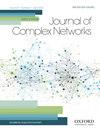Analysis of quantile graphs in EGC data from elderly and young individuals using machine learning and deep learning
IF 1.5
4区 数学
Q2 MATHEMATICS, INTERDISCIPLINARY APPLICATIONS
引用次数: 0
Abstract
Abstract Heart disease, also known as cardiovascular disease, encompasses a variety of heart conditions that can result in sudden death for many people. Examples include high blood pressure, ischaemia, irregular heartbeats and pericardial effusion. Electrocardiogram (ECG) signal analysis is frequently used to diagnose heart diseases, providing crucial information on how the heart functions. To analyse ECG signals, quantile graphs (QGs) is a method that maps a time series into a network based on the time-series fluctuation proprieties. Here, we demonstrate that the QG methodology can differentiate younger and older patients. Furthermore, we construct networks from the QG method and use machine-learning algorithms to perform the automatic diagnosis, obtaining high accuracy. Indeed, we verify that this method can automatically detect changes in the ECG of elderly and young subjects, with the highest classification performance for the adjacency matrix with a mean area under the receiver operating characteristic curve close to one. The findings reported here confirm the QG method’s utility in deciphering intricate, nonlinear signals like those produced by patient ECGs. Furthermore, we find a more significant, more connected and lower distribution of information networks associated with the networks from ECG data of the elderly compared with younger subjects. Finally, this methodology can be applied to other ECG data related to other diseases, such as ischaemia.使用机器学习和深度学习分析老年人和年轻人EGC数据的分位数图
心脏病,也被称为心血管疾病,包括各种心脏疾病,可导致许多人猝死。例如高血压、缺血、心律不齐和心包积液。心电图(ECG)信号分析经常用于诊断心脏病,提供心脏功能的重要信息。分位数图(QGs)是一种基于时间序列波动特性将时间序列映射到网络中的方法。在这里,我们证明了QG方法可以区分年轻和老年患者。此外,我们从QG方法构建网络,并使用机器学习算法进行自动诊断,获得了较高的准确性。实际上,我们验证了该方法可以自动检测老年人和年轻人的ECG变化,并且在接收者工作特征曲线下的平均面积接近1的邻接矩阵具有最高的分类性能。本文报道的研究结果证实了QG方法在破译复杂的非线性信号(如患者心电图产生的信号)方面的实用性。此外,我们发现与年轻受试者相比,老年人的心电数据中与网络相关的信息网络更显著、更连通、分布更低。最后,该方法可以应用于与其他疾病相关的其他心电图数据,如缺血。
本文章由计算机程序翻译,如有差异,请以英文原文为准。
求助全文
约1分钟内获得全文
求助全文
来源期刊

Journal of complex networks
MATHEMATICS, INTERDISCIPLINARY APPLICATIONS-
CiteScore
4.20
自引率
9.50%
发文量
40
期刊介绍:
Journal of Complex Networks publishes original articles and reviews with a significant contribution to the analysis and understanding of complex networks and its applications in diverse fields. Complex networks are loosely defined as networks with nontrivial topology and dynamics, which appear as the skeletons of complex systems in the real-world. The journal covers everything from the basic mathematical, physical and computational principles needed for studying complex networks to their applications leading to predictive models in molecular, biological, ecological, informational, engineering, social, technological and other systems. It includes, but is not limited to, the following topics: - Mathematical and numerical analysis of networks - Network theory and computer sciences - Structural analysis of networks - Dynamics on networks - Physical models on networks - Networks and epidemiology - Social, socio-economic and political networks - Ecological networks - Technological and infrastructural networks - Brain and tissue networks - Biological and molecular networks - Spatial networks - Techno-social networks i.e. online social networks, social networking sites, social media - Other applications of networks - Evolving networks - Multilayer networks - Game theory on networks - Biomedicine related networks - Animal social networks - Climate networks - Cognitive, language and informational network
 求助内容:
求助内容: 应助结果提醒方式:
应助结果提醒方式:


